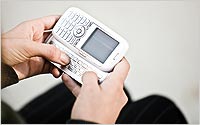Text Donors Younger, More Tech-Centric
- by Mark Walsh @markfwal, January 12, 2012
 Two years after the “Text to Haiti” campaign for victims of the earthquake that devastated the Caribbean nation, a new study finds that mobile giving has become more common. A majority (56%) have continued to make donations to more
recent disaster relief efforts, including the March 2011 earthquake and tsunami in Japan -- via mobile phones, according to research by the Pew Research Center and Harvard’s Berkman Center for
the Internet & Society.
Two years after the “Text to Haiti” campaign for victims of the earthquake that devastated the Caribbean nation, a new study finds that mobile giving has become more common. A majority (56%) have continued to make donations to more
recent disaster relief efforts, including the March 2011 earthquake and tsunami in Japan -- via mobile phones, according to research by the Pew Research Center and Harvard’s Berkman Center for
the Internet & Society.
Two-thirds (64%) of American adults use text messaging overall, and 9% have texted a charitable donation from their mobile device. A random survey of 863 donors to the Red Cross’s path-breaking “Text to Haiti” campaign found it was the first time three-quarters of them had texted a donation, and 80% gave only through their mobile phone.
For most, it was a also a spur-of-the-moment decision that spread virally through friend networks.
About three-quarters (73%) contributed the same day they heard the news, and a similar proportion (76%) said they typically make text donations without conducting much in-depth research beforehand. Even so, 43% encouraged their friends or family members to give as well. The Red Cross raised $32 million through mobile giving in the month following the disaster in Haiti.
However, the initial outpouring of support via text-based giving has not resulted in lasting interest or engagement with relief or rebuilding work there. Six in 10 text-donors have not followed ongoing reconstruction in Haiti closely after making their donation. One possible reason for that lack of engagement: a sizeable majority (80%) have not received additional follow-up communications from the organization that received their donation.
When asked how they prefer to make charitable donations, the Haiti donors said they prefer text messaging (favored by 25%) and online forms (24%) only slightly to mail (22%) and in-person donations (19%). Phone calling stands out as the least attractive option, with just 6% choosing to make donations over the phone. (Hence the popularity of the do-not-call list.)
The study also found that mobile givers are younger and more diverse compared with other charitable donors, and differ significantly from the overall population when it comes to the use of technology. For example, they are more likely to:
-Own an e-reader (24% compared with 9% of all U.S. adults), laptop computer (82% vs. 57%) or tablet computer (23% vs. 10%).
-Use Twitter (23% of the Haiti donors who go online use Twitter compared to 12% of all online adults) or social networking sites (83% vs. 64%).
-Use their phones for activities such as accessing the Internet (74% vs. 44% of all adult cell owners), taking pictures (96% vs. 73%) or recording video (67% vs. 34%).
While unique in their technology habits, text donors differed little from the national average in terms of their overall civic engagement and group participation, as well as a tendency to keep up with national or international news.
In the aftermath of the Text-To-Haiti campaign, many in the mobile advertising world pointed to it as a proof of the power of SMS as a marketing tool. The Pew Center’s Aaron Smith, who authored the report, said he was reluctant to draw conclusions about the Haiti campaign beyond the nonprofit sector.
The report did not address issues that have since been raised about mobile giving -- including whether wireless service providers may charge fees or take a cut of donations. It can take as long as 120 days for a charity to actually receive a text donation.


